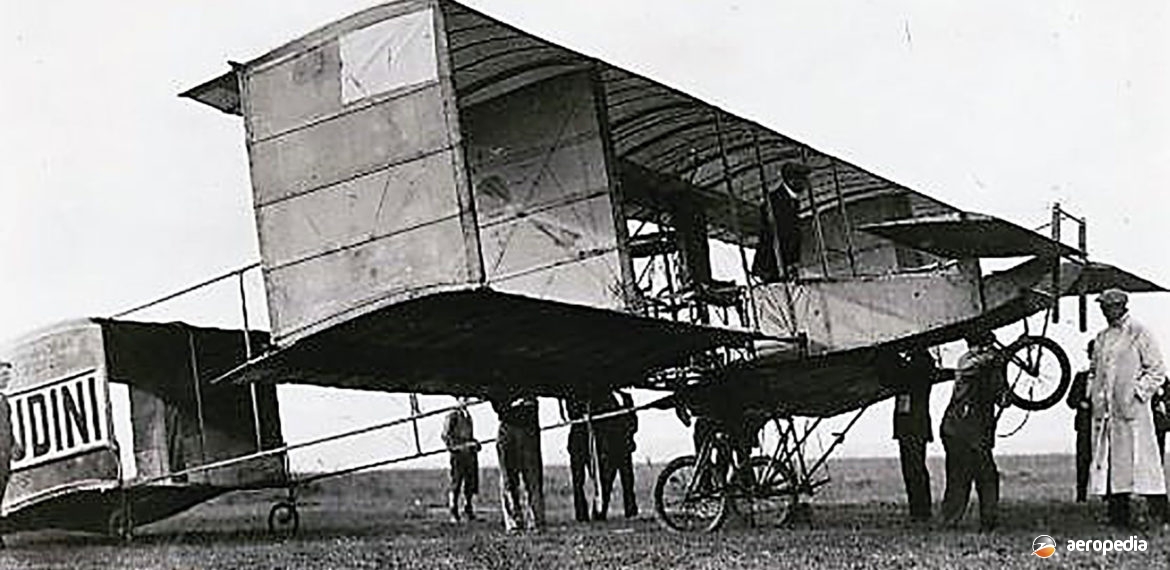Photograph:
Voisin flown by Harry Houdini (Eric Weiss) in Sydney, NSW 1910 (E A Chrome Collection – Nat Lib of Australia)
Country of origin:
France
Description:
Two-seat biplane
Power Plant:
One 30 kw (40 hp) ENV engine
Specifications:
- Wingspan: 10.05 m (33 ft)
- Length: 10.54 m (34 ft 6 in)
- Height: 3.96 m (13 ft)
- Wing area: 51.09 m² (550 sq ft)
- Max speed: 55 km/ h (34 mph)
- Empty weight (without engine): 263 kg (580 lb)
History:
The brothers Charles (1882 – 1912) and Gabriel (1880 – 1973) Voisin in France in the 19th Century began building and experimenting with kites, incorporating modified Lawrence Hargrave type box-kite structures, and in 1905, in association with Ernest Archdeacon and Louis Bleriot, built gliders. These were developed to a series of aircraft of biplane configuration with a boxkite type tail structure with the engine in pusher configuration. The early aircraft were not particularly successful, but an aircraft was built for Henri Farman known as the Voisin-Farman I with a 37 kw (50 hp) Antoinette engine and it was successfully flown in October 1907. On 13 January 1908 Henri Farman flew the first one kilometre circuit in a Voisin, winning a 50,000-Franc prize and much acclaim.
As World War I approached a number of designs were built, and by 1912 Les Freres Voisin had produced more than 75 machines all based on the 1907 design but thereafter nearly all aircraft were built to military contracts. New types built included the Type LA or Type III in February 1914 which had an 89 kw (120 hp) Salmson M9 engine. It was licence built by the British Savage Co and nearly 1,000 were built, the last in 1920.
A Voisin built by Voisin Freres in France was brought to Australia. This was probably one of the 75 aircraft noted above built at the Voisin Factory at Rue de la Ferme, Billancourt in Paris, this facility being set up in about early 1908. The framework was of wood and steel tubing with fabric covering. Control was by a single wheel, stability being automatic by four upright fixed planes (known also as side curtains) between the main planes. Three engines were available to be installed, the 30 kw (40 hp) ENV, the 37 kw (50 hp) Gnome, and the 37 kw (50 hp) JAP, all driving a two-blade steel and wood propeller 1.98 m (6 ft 6 in) in diameter by direct drive. The radiator for the engine was between the pilot and the engine. The wings were 10.05 m (33 ft) long by 2.10 m (6 ft 9 in) wide.
The Voisin, complete with ENV engine, cost £780 ($1,560) in the United Kingdom when it first became available, and tuition was provided free in Paris or London to the purchaser. The manufacturer guaranteed a flight of 8 km (5 miles). Well known aviators of the time who flew the type included Rougier, Paulhan, Fournier, Moore-Brabazon, Singer, Sanches Besa, Delagrange, Ferber and Weisz.
Ehrich Weisz, an illusionist and stunt performer (commonly known as Eric Weiss or by the stage name Harry Houdini), was born in Budapest, Hungary and emigrated with his family to the United States. He was at an aviation meeting at Reims in France in August 1909 when he saw famous aviators such as Bleriot, Henri Farman, and Glen Curtiss, flying around the pylons of a measured race course. A mechanics race was held and this was won by Franz Brassac in a Voisin. Weisz then bought the machine but it appears he had an accident in the machine in Germany, damage being occasioned to the undercarriage, the propeller and the fuel tank. He then had it shipped to Australia in four crates, travelling by ship from Marseilles in France.
Ehrich Weisz arrived in Melbourne, VIC on board the SS Mawela with the Voisin and a mechanic. The aeroplane was transported to Diggers Rest near Sunbury, VIC and assembled. An attempt was made to fly on 17 March 1910 but failed due to engine problems. Shortly after 8 am on 18 March 1910 Ehrich Weisz made a successful flight in his Voison B Biplane powered by a 45 kw (60 hp) ENV engine at an old plantation paddock at Diggers Rest, about 32 km (20 miles) north of Melbourne. These flights are considered by some to be the first completed and recognised flights in Australia, being observed by members of the Aerial League of Australia, although others believe the flights at Sydney’s Victoria Park Racecourse on 9 December 1909 by Colin Defries to be the first truly successful sustained controlled flight.
Further flights were made ranging from one to three and a half minutes on 19, 20 and 21 March 1910, and one flight at one stage lasted seven minutes and 37 seconds. Further flight attempts were made at the Rosehill Racecourse in Sydney, NSW on 18 April 1910 but these were only partially successful, the aircraft being damaged in a crash landing as problems were experienced with strong winds.
There is a number of reports about the engine fitted to this machine. Advertisements of the time say the Voisin was fitted with a 30 kw (40 hp) ENV; others say a 45 kw (60 hp) ENV; and another refers to a 60 kw (80 hp) Enfield petrol motor which weighed 109 kg (240 lb), which had a steel shafted aluminium propeller 2.43 m (8 ft) long which turned at 1,200 rpm.
On 11 May 1910 Weisz left Australia for North America on board the SS Manika, the Voison being crated and loaded on the ship. It was later sold and it is not believed he flew again. He died from peritonitis in hospital in Detroit, USA on 31 October 1926 at the age of 52.

